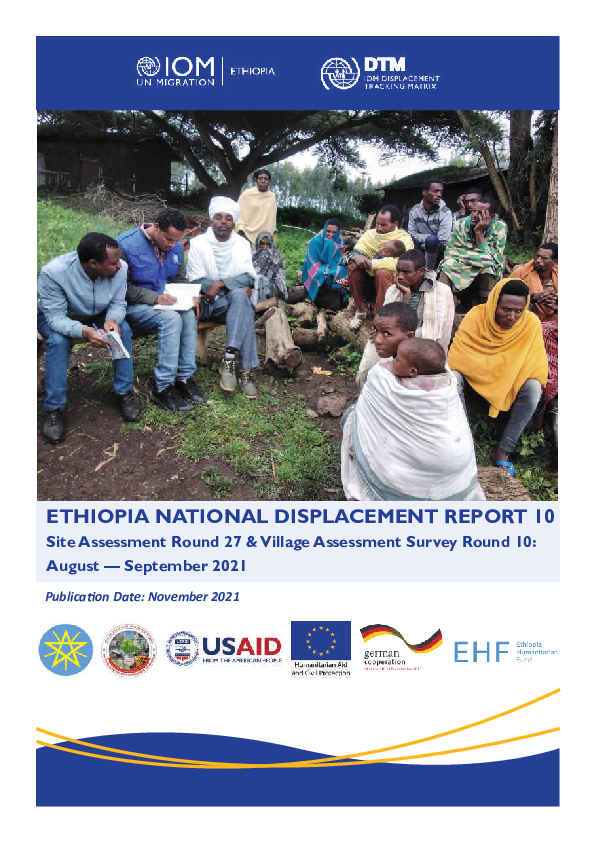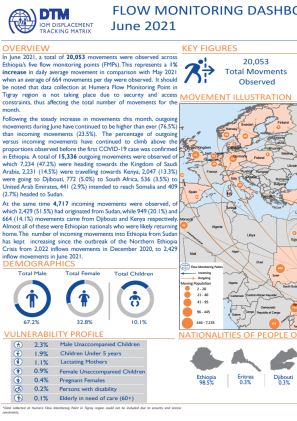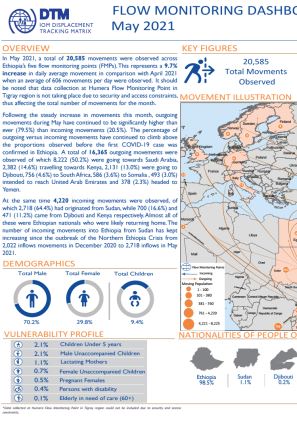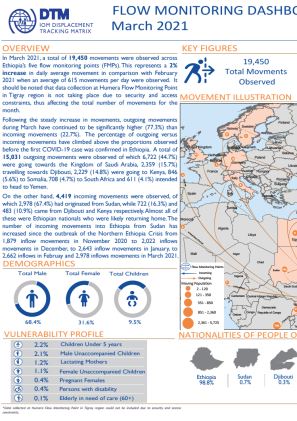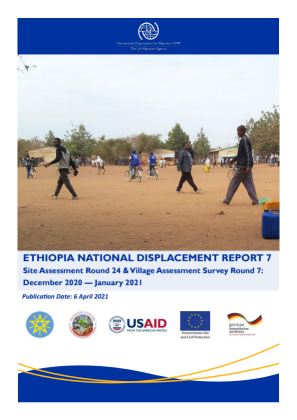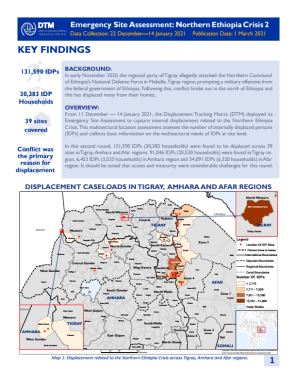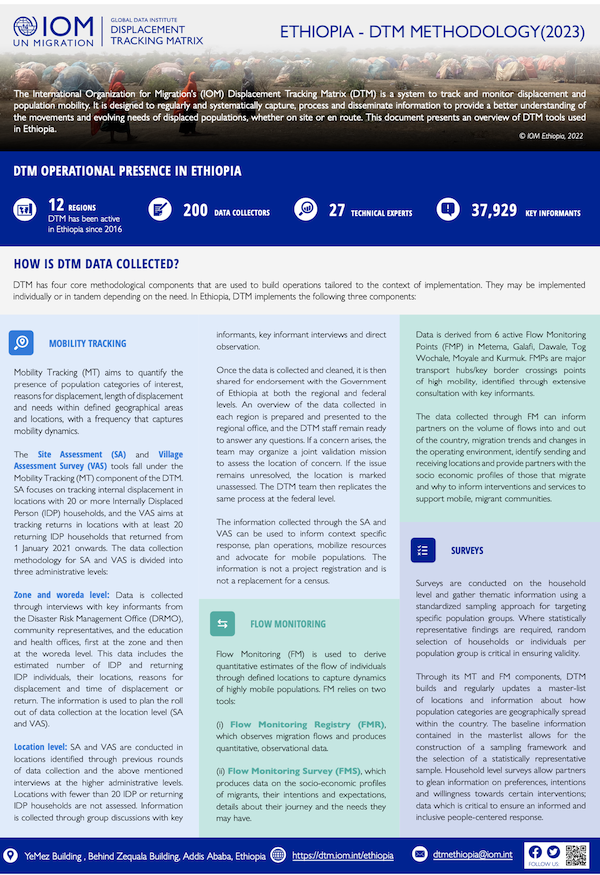-
Countries
-
Data and Analysis
-
Special Focus
-
Crisis Responses
Ethiopia
Error message
The submitted value field_published_date_value in the Sort by element is not allowed.
About Ethiopia
Ethiopia faces one of the most complex human mobility environments in the world, with a range of social, economic, political, and climatic factors driving populations within and outside its borders.
IOM’s Displacement Tracking Matrix (DTM) is a system that monitors human mobility within Ethiopia to provide essential insights into the location, vulnerabilities, demographic breakdown and needs of displaced and mobile populations to provide the Government of Ethiopia, humanitarian and development partners, as well as donors and other relevant stakeholders with a useful evidence base for planning, advocacy, and response.
Since its launch in September 2016 in Ethiopia, the DTM has grown to be a fully integrated component of Ethiopia’s national and sub-national information management architecture, as it is the official source of data on internal displacement in the country.
In Ethiopia, mobility tracking captures internal displacement and return through three annual rounds of Site Assessments (focused on IDPs and the availability of services in their areas of displacement) as well as returning IDPs through the Village Assessment Surveys (focused on host community capacity to absorb returns targeting IDPs, returning IDPs, returned migrants and host community members and their access to services with a focus on livelihoods and reintegration). Mobility tracking data is largely used to inform humanitarian response and development planning and as such is coordinated with both humanitarian and development actors in country as well as with the Ethiopia Disaster Risk Management Commission. Flow Monitoring captures inter-and intra-regional migration flows daily at key identified transit locations. This information is largely used to inform more developmental programming including migrant assistance and protection programming. This data is also shared with humanitarian and development counterparts in the country and is collected in close coordination with the Ministry of Labor and Social Affairs. Both DTM components intend to provide an evidence-base for programming and policy that is increasingly integrated and area-based. In addition to mobility tracking and flow monitoring, DTM Ethiopia also deploys thematic household level surveys to provide representative, granular information which can be triangulated with pre-existing DTM data collected through key informants and focus group discussions. This data enables the humanitarian and development communities to obtain important insight into the needs, conditions, vulnerabilities, and intentions of IDPs which can be particularly useful in informing programs, especially with regards to durable solutions, livelihoods, and other Humanitarian Development Nexus (HDN) related programming and policy initiatives.
DTM Ethiopia currently deploys over 200 staff and enumerators to track displacement, returns and migrant movements in the country.
Current Donors
- USAID
- ECHO
- Canada
- Japan
- EHF
Ethiopia — Flow Monitoring Dashboard 27 (December 2021)
In December 2021, a total of 18,049 movements were observed across five of Ethiopia's flow monitoring points (FMPs).
Ethiopia — Flow Monitoring Dashboard 26 (November 2021)
In November 2021, a total of 16,619 movements were observed across five of Ethiopia's flow monitoring points (FMPs).
Ethiopia — National Displacement Report 10 (August - September 2021)
In order to capture the displacement and return dynamics in Ethiopia, DTM Ethiopia's National Displacement Report combines findings from its Site Assessment (SA) in Section 1 and findings from the Village Assessment Survey (VAS) in Section 2.
Ethiopia — Emergency Site Assessment 8 (27 July - 4 October 2021)
From 27 July— 4 October 2021, the Displacement Tracking Matrix (DTM) deployed its Emergency Site Assessment (ESA) to capture internal displacement related to the Northern Ethiopia Crisis.
Ethiopia — Flow Monitoring Dashboard 25 (October 2021)
In October 2021, a total of 14,227 movements were observed across four of Ethiopia's flow monitoring points (FMPs).
Ethiopia — Flow Monitoring Dashboard 24 (September 2021)
In September 2021, a total of 20,910 movements were observed across five of Ethiopia's flow monitoring points (FMPs).
Ethiopia — Flow Monitoring Dashboard 23 (August 2021)
In August 2021, a total of 23,724 movements were observed across five of Ethiopia's flow monitoring points (FMPs).
Ethiopia — National Displacement Report 9 (June — July 2021)
In order to capture the displacement and return dynamics in Ethiopia, DTM Ethiopia's National Displacement Report combines findings from its Site Assessment (SA) in Section 1 and findings from the Village Assessment Survey (VAS) in Section 2.
Ethiopia — Household Level Intention Survey: Tigray Region (July 2021)
In July 2021, the International Organization for Migration (IOM)'s Displacement Tracking Matrix (DTM), Camp Coordinaton and Camp Management (CCCM) Cluster and Protection Cluster worked together to carry out household level intention surveys in Tigray region for the first time. In response to this
Ethiopia — Flow Monitoring Dashboard 22 (July 2021)
In July 2021, a total of 22,046** movements were observed across Ethiopia’s five flow monitoring points (FMPs).
Ethiopia — Emergency Site Assessment 7 (1 — 26 June 2021)
From 1— 26 June 2021, the Displacement Tracking Matrix (DTM) deployed its Emergency Site Assessment to capture internal displacement related to the Northern Ethiopia Crisis.
Ethiopia — Flow Monitoring Dashboard 21 (June 2021)
In June 2021, a total of 20,053 movements were observed across Ethiopia’s five flow monitoring points (FMPs). Following the steady increase in movements this month, outgoing movements during June have continued to be higher than ever (76.5%) than incoming movements (23.5%). The percentage of out
Ethiopia — Flow Monitoring Dashboard 20 (May 2021)
n May 2021, a total of 20,585 movements were observed across Ethiopia’s five flow monitoring points (FMPs). Following the steady increase in movements this month, outgoing movements during May have continued to be significantly higher than ever (79.5%) than incoming movements (20.5%). The percent
Ethiopia — National Displacement Report 8 (March — April 2021)
In order to capture the displacement and return dynamics in Ethiopia, DTM Ethiopia's National Displacement Report combines findings from its Site Assessment (SA) in Section 1 and findings from the Village Assessment Survey (VAS) in Section 2.
Ethiopia — Emergency Site Assessment 6 (3 — 24 May 2021)
From 3 — 24 May 2021, the Displacement Tracking Matrix (DTM) deployed its Emergency Site Assessment to capture internal displacement related to the Northern Ethiopia Crisis.
Ethiopia — Emergency Site Assessment 5 (1 — 22 April 2021)
From 1 — 22 April 2021, the Displacement Tracking Matrix (DTM) deployed its Emergency Site Assessment to capture internal displacement related to the Northern Ethiopia Crisis.
Ethiopia — Flow Monitoring Dashboard 19 (April 2021)
In April 2021, a total of 18,166 movements were observed across Ethiopia’s five flow monitoring points (FMPs). This represents a 3% decrease in daily average movement in comparison with March 2021 when an average of 627 movements per day were observed.
Ethiopia — Flow Monitoring Dashboard 18 (March 2021)
In March 2021, a total of 19,450 movements were observed across Ethiopia’s five flow monitoring points (FMPs). Following the steady increase in movements, outgoing movements during March have continued to be significantly higher (77.3%) than incoming movements (22.7%). The percentage of outgoing
Ethiopia — Emergency Site Assessment 4 (2 — 23 March 2021)
From 2 — 23 March 2021, the Displacement Tracking Matrix (DTM) deployed its Emergency Site Assessment to capture internal displacement related to the Northern Ethiopia Crisis.
Ethiopia — National Displacement Report 7 (December 2020 — January 2021)
In order to capture the displacement and return dynamics in Ethiopia, DTM Ethiopia's National Displacement Report combines findings from its Site Assessment (SA) in Section 1 and findings from the Village Assessment Survey (VAS) in Section 2.
Ethiopia — Emergency Site Assessment 3 (2 — 26 February 2021)
In early November 2020, conflict broke out in the north of Ethiopia and this has displaced many from their homes. From 2 — 26 February 2021, the Displacement Tracking Matrix (DTM) deployed its Emergecny Site Assessment to capture internal displacement related to the Northern Ethiopia Crisis.
Ethiopia — Flow Monitoring Dashboard 17 (February 2021)
In February 2021, a total of 17,216 movements were observed across Ethiopia’s five flow monitoring points (FMPs) whereby outgoing movements during February have continued to be significantly higher (77%) than incoming movements (23%). The percentage of outgoing versus incoming movements have clim
Ethiopia — Flow Monitoring Dashboard 16 (January 2021)
In January 2021, a total of 17,316 movements were observed across Ethiopia’s five flow monitoring points (FMPs) whereby outgoing movements during January have continued to be significantly higher (77%) than incoming movements (23%). The percentage of outgoing versus incoming movements have climbe
Ethiopia — Emergency Site Assessment 2 (22 December 2020 — 14 January 2021)
In early November 2020, conflict broke out in the north of Ethiopia and this has displaced many from their homes. From 11 December — 14 January 2021, the Displacement Tracking Matrix (DTM) deployed its Emergecny Site Assessment to capture internal displacement related to the Northern Ethiopia Cri
Pagination
Ethiopia - Site Assessment Round 20
2019-11-29
A site assessment is a sub-component of mobility tracking. It aims to collect data on population presence, living conditions and needs in a particular displacement site or community.
Ethiopia — Village Assessment Survey — Round 2
2019-10-12
A village assessment survey (VAS) is a sub-component of mobility tracking. It collects data on returning IDPs, IDPs, returned migrants and host community members. VAS evaluates the absorption capacity of villages to receive returning IDPs with a focus on accessibility of services, livelihoods and…
Ethiopia - Site Assessment Round 19
2019-09-30
A site assessment is a sub-component of mobility tracking. It aims to collect data on population presence, living conditions and needs in a particular displacement site or community.
Ethiopia - Site Assessment Round 18
2019-07-30
A site assessment is a sub-component of mobility tracking. It aims to collect data on population presence, living conditions and needs in a particular displacement site or community.
Ethiopia - Site Assessment Round 17
2019-06-30
A site assessment is a sub-component of mobility tracking. It aims to collect data on population presence, living conditions and needs in a particular displacement site or community.
Ethiopia - Village Assessment Survey — Round 1
2019-06-26
A village assessment survey (VAS) is a sub-component of mobility tracking. It collects data on returning IDPs, IDPs, returned migrants and host community members. VAS evaluates the absorption capacity of villages to receive returning IDPs with a focus on accessibility of services, livelihoods and…
Ethiopia - Site Assessment - Round 16
2019-04-30
A site assessment is a sub-component of mobility tracking. It aims to collect data on population presence, living conditions and needs in a particular displacement site or community.
Ethiopia - East and West Wellega Rapid Response Site Assessment Round 2
2019-04-10
The DTM Rapid Response Assessment tool is designed to provide detailed information at site level for emergencies occurring outside the DTM Mobility Tracking data collection periods. IDP community leaders collaborated closely with IOM as key informants during the assessment with the aim to provide…
Ethiopia - Gedeo/West Guji Rapid Response Site Assessment Round 6
2019-03-17
The DTM Rapid Response Assessment tool is designed to provide detailed information at site level for emergencies occurring outside the DTM Mobility Tracking data collection periods. IDP community leaders collaborated closely with IOM as key informants during the assessment with the aim to provide…
Ethiopia - Site Assessment Round 15
2019-02-28
A site assessment is a sub-component of mobility tracking. It aims to collect data on population presence, living conditions and needs in a particular displacement site or community.
Ethiopia - Site Assessment Round 14
2018-12-31
A site assessment is a sub-component of mobility tracking. It aims to collect data on population presence, living conditions and needs in a particular displacement site or community.
Ethiopia - Gedeo/West Guji Rapid Response Host Community IDP Assessment Round 4
2018-11-30
The DTM Rapid Response Assessment tool is designed to provide detailed information at site level for emergencies occurring outside the DTM Mobility Tracking data collection periods. IDP community leaders collaborated closely with IOM as key informants during the assessment with the aim to provide…
Ethiopia - Site Assessment Round 13
2018-10-31
A site assessment is a sub-component of mobility tracking. It aims to collect data on population presence, living conditions and needs in a particular displacement site or community.
Ethiopia - Site Assessment Round 12
2018-08-31
A site assessment is a sub-component of mobility tracking. It aims to collect data on population presence, living conditions and needs in a particular displacement site or community.
Ethiopia — Gedeo/West Guji Rapid Response — Host Community Dataset — Site Assessment — Round 2
2018-08-23
The DTM Rapid Response Assessment tool is designed to provide detailed information at site level for emergencies occurring outside the DTM Mobility Tracking data collection periods. IDP community leaders collaborated closely with IOM as key informants during the assessment with the aim to provide…
Ethiopia — Gedeo/West Guji Rapid Response — Collective Center Dataset — Site Assessment — Round 2
2018-08-23
The DTM Rapid Response Assessment tool is designed to provide detailed information at site level for emergencies occurring outside the DTM Mobility Tracking data collection periods. IDP community leaders collaborated closely with IOM as key informants during the assessment with the aim to provide…
Ethiopia - Site Assessment Round 11
2018-06-30
A site assessment is a sub-component of mobility tracking. It aims to collect data on population presence, living conditions and needs in a particular displacement site or community.
Ethiopia - Site Assessment Round 10
2018-04-30
A site assessment is a sub-component of mobility tracking. It aims to collect data on population presence, living conditions and needs in a particular displacement site or community.
Ethiopia — Baseline Assessment 1F Round 9
2018-02-09
A baseline assessment is a sub-component of mobility tracking. It aims to collect data on IDP, migrant or returnee population presence in a defined administrative area of the country.
Ethiopia — Baseline Assessment 2F Round 9
2018-02-07
A baseline assessment is a sub-component of mobility tracking. It aims to collect data on IDP, migrant or returnee population presence in a defined administrative area of the country.




